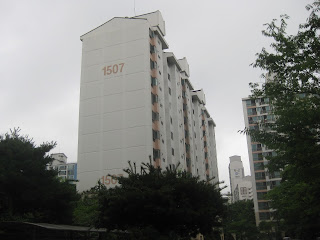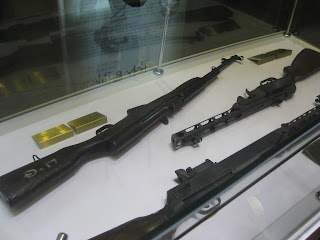The first home stay group got off the bus. The second group, which I was part of, drove to Gyeonbokgung (Gyeonbok Palace). It was here that we met our home stay family.
We were assigned to a home stay family in groups. The groups typically consisted of two educators or two family members, along with one of the Korean American youths who were on the trip (who could speak Korean!). Although I was excited about this part of the trip, as I think back on it, I was also pretty nervous! I really did not know what to expect.
The family I was placed with actually lived outside of Seoul, in Ilsan. Ilsan is northwest of Seoul. Its claim to fame is that it has the largest artificial lake in Asia. Unfortunately, it was POURING rain and we did not get to see it.
We stuffed our luggage into their car and drove to their apartment. This family is connected with InKAS, and has been hosting Sejong visitors for many years. Mr. Kim is a psychologists - such a perfect fit! He focuses mostly on statistics, researching, and teaching. A recent project he did was to compile the normative data for a vocational measure. In addition, he runs an on-line Korean language learning program and has taught Korean language through a program at Yongsei University. Mrs. Lee focuses on her children and an organic farming program the family has. Most people in the area have farming plots located outside of the city to grow their own vegetables. Their plot is larger than most families. They have a program to teach others about farming methods. I also gathered that they sell some of their extra produce. The two daughters are students in neighborhood schools. They were pretty shy with us. The older daughter was in the midst of exams and had spent most of the day taking her Japanese language exam.
 They took us to visit a children's library near their house. I am not sure I fully understand the program, but I think it was a library aimed at providing impoverished children with access to books and learning programs.
They took us to visit a children's library near their house. I am not sure I fully understand the program, but I think it was a library aimed at providing impoverished children with access to books and learning programs.We then went to dinner. I have never seen so much food! It was shabu-shabu, which is something that was new to me. There was a pot of boiling broth on the table. As we ate, we added thinly sliced beef and vegetables to the pot. It was delicious!
 We came back and home and we were offered more food! We exchanged gifts. I had brought the family a picture album of my kids and my family. I brought the girls' Fairport nylon backpacks with cute office supplies.
We came back and home and we were offered more food! We exchanged gifts. I had brought the family a picture album of my kids and my family. I brought the girls' Fairport nylon backpacks with cute office supplies.That night we slept in the traditional Korean style - on thick blankets on the floor. Either it was not too bad or I was too tired to feel uncomfortable, but I slept fine! We had a traditional Korean breakfast in the morning of rice and vegetables (many grown in their own garden!). We had the most delicious pear/cucumber cold soup I ever had. I am going to try to make it at home soon.
We said our goodbyes and the luggage went back into the car. Mr. Kim dropped us off at Ewha University (which I will talk about in the next post!). Some people on the trip stayed with their families for two nights, but we only stayed one night. Ilsan is too far from the airport that we needed to be at early in the morning for our flight to JeJu Island. We stayed our second night at a hotel near the airport.




















